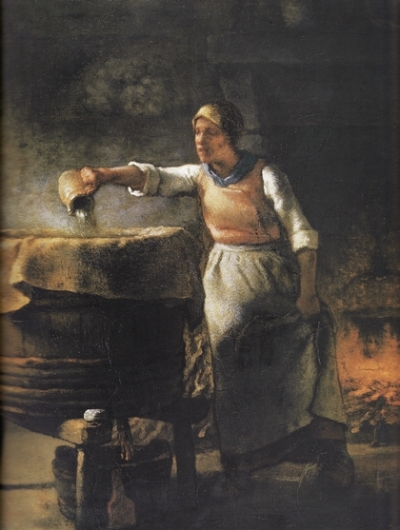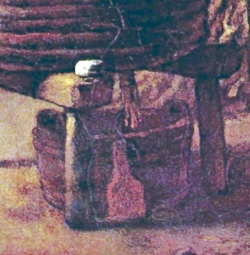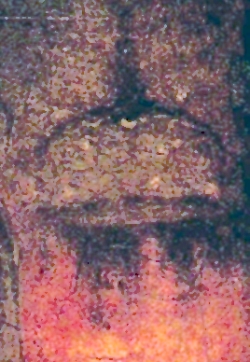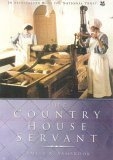-
History of:
- Resources about:
- More:
- Baby walkers
- Bakehouses
- Bed warmers
- Beer, ale mullers
- Besoms, broom-making
- Box, cabinet, and press beds
- Butter crocks, coolers
- Candle snuffers, tallow
- Clothes horses, airers
- Cooking on a peat fire
- Drying grounds
- Enamel cookware
- Fireplaces
- Irons for frills & ruffles
- Knitting sheaths, belts
- Laundry starch
- Log cabin beds
- Lye and chamber-lye
- Mangles
- Marseilles quilts
- Medieval beds
- Rag rugs
- Rushlights, dips & nips
- Straw mattresses
- Sugar cutters - nips & tongs
- Tablecloths
- Tinderboxes
- Washing bats and beetles
- Washing dollies
- List of all articles
Subscribe to RSS feed or get email updates.
...cover [the tub] with a large cloth folded in four, wide enough to hang down 30 cms over the rim of the tub ... spread out the ashes in an even layer...wet the ashes, of which you will need 10 litres for 100 litres of wet linen. The ashes need to be good quality, or you will need to add some potash or soda crystals, once the water starts to get warm....
Start by heating the water gently in the boiler and increase the heat gradually, to avoid scalding ... pour the water onto the tub using a metal stewpot.... the lye must be run through the laundry for at least twelve hours ... leave the linen dripping in the tub overnight...
In places where coal is the only fuel, it is impossible to obtain good ashes; you must replace them with carbonate of soda...6 kilos of soda, a half kilo of grated soap and 50 litres of water are enough for 200 kilos of linen.
Loosely translated from:
Jules Trousset, Grande encyclopédie illustrée d'économie domestique, 1875
This book has about 100 pages on old laundry practices, including the use of lye:
The Country House Servant from Amazon.com
Or from Amazon.UK
...the coarse and worst housewives scour and white their cloth with water and bran, and buck it with lye and green hemlocks.
Gervase Markham, The English Housewife, 1615
Ashes in the washtub
Bucking with lye, the buck wash
 At
last we have found a picture showing the old way of bucking laundry in lye. Bucking was
a washing method known in late medieval times, and was still in use in the 19th
century, though by then it was being replaced by the tub filled with suds, for the
weekly soap wash we now think of as "traditional".
At
last we have found a picture showing the old way of bucking laundry in lye. Bucking was
a washing method known in late medieval times, and was still in use in the 19th
century, though by then it was being replaced by the tub filled with suds, for the
weekly soap wash we now think of as "traditional".
The buck wash was a relatively infrequent cleansing of household linen and clothes. (More about this in the Great Wash.) In the water were "bleaches" like ashes or urine. As bucking gradually became less popular during the 18th and 19th centuries it was sometimes combined with, or alternated with, a soap wash.
Millet painted the Lessiveuse in the 1850s: a woman heating water and pouring it onto her laundry through a layer of ashes spread on a bucking-cloth. The bucking-tub is raised on a frame, and a plug-hole allows the water to run out into a bucket underneath. For many hours, the water passes through the tubful of laundry, as it is re-heated and poured back in over and over again.
This was also the way to bleach newly-woven cloth and newly-spun yarn:
.....cover the uppermost yarn with a bucking cloth, and lay therein a peck [about 16 pints] or two (according to the bigness of the tub) of ashes more; then pour into all through the uppermost cloth so much warm water, till the tub can receive no more; and so let it stand all night: the next morning you shall pull out the spigot [peg used to stop hole] of the bucking tub, and let the water therein run into another clean vessel, and as the bucking tub wasteth, so shall you fill it up again with the lye which cometh from the bucking tub, ever observing to make the lye hotter and hotter till it seethe [boil].....
Gervase Markham, The English Housewife, 1615
 In the 14th century bucking laundry is mentioned in Piers Plowman, re-phrased
as a "thorough soaking" in one modern translation
In the 14th century bucking laundry is mentioned in Piers Plowman, re-phrased
as a "thorough soaking" in one modern translation. Of course there must have been various styles of bucking
in different times and places. The elaborate heating and re-heating process didn't
always happen. Bucking for poorer households could mean soaking with little or no
heat. Fuel was expensive and so were large metal tubs until factories started
mass producing them. Urine or even dung could be the "detergent"
used instead of ashes.
Very often [lye] was strengthened by adding bran, stale urine or water in which dung had been steeped....The use of lye survived into the nineteenth century in both cottage and middling households probably because all the constituent materials were household waste products......Some woods were better than others - ash, apple and pear wood gave a very strong bleaching action, oak tended to give a bad colour.
Pamela A. Sambrook, The Country House Servant, 1999
Since bucking used wood-ash, this may be one reason why the technique lasted longer in France than in coal-rich Britain. By the time Millet painted his French washerwoman, very few British households still bucked their clothes in lye, unless they had to economise on soap. Meanwhile in late 19th century France running lye through the laundry, a process called the coulée, was still important and was described in manuals on domestic economy. (See left-hand column) One blogger's grandmother could remember the coulée in her lifetime. Some women in 1940s Italy returned to laundering in lye during war-time soap shortages, according to Pamela Sambrook.
 Under the tub, Millet paints the water running out to be collected for re-heating
in the cauldron hanging in the fireplace. Over the tub is the bucking-cloth holding
the ashes. (A
lye-dropper was an alternative to the cloth in the UK.) The
washing bat, of a typical French shape, sits ready for use, and there
is soap.
Under the tub, Millet paints the water running out to be collected for re-heating
in the cauldron hanging in the fireplace. Over the tub is the bucking-cloth holding
the ashes. (A
lye-dropper was an alternative to the cloth in the UK.) The
washing bat, of a typical French shape, sits ready for use, and there
is soap.
La Lessiveuse is sometimes translated as the Woman Making Lye, which may mislead some people to believe she is preparing lye for soap-making. It has also been translated as the Wash Tub. In French lessiveuse can mean either a washerwoman or a washing boiler. It is generally taken to mean washerwoman here.
For more on laundry history and old washing methods go to
>>>> History of laundry and
>>>> Laundry from 1800
 30 January 2008
30 January 2008
You may like our new sister site Home Things Past where you'll find articles about antiques, vintage kitchen stuff, crafts, and other things to do with home life in the past. There's space for comments and discussion too. Please do take a look and add your thoughts. (Comments don't appear instantly.)
For sources please refer to the books page, and/or the excerpts quoted on the pages of this website, and note that many links lead to museum sites. Feel free to ask if you're looking for a specific reference - feedback is always welcome anyway. Unfortunately, it's not possible to help you with queries about prices or valuation.



